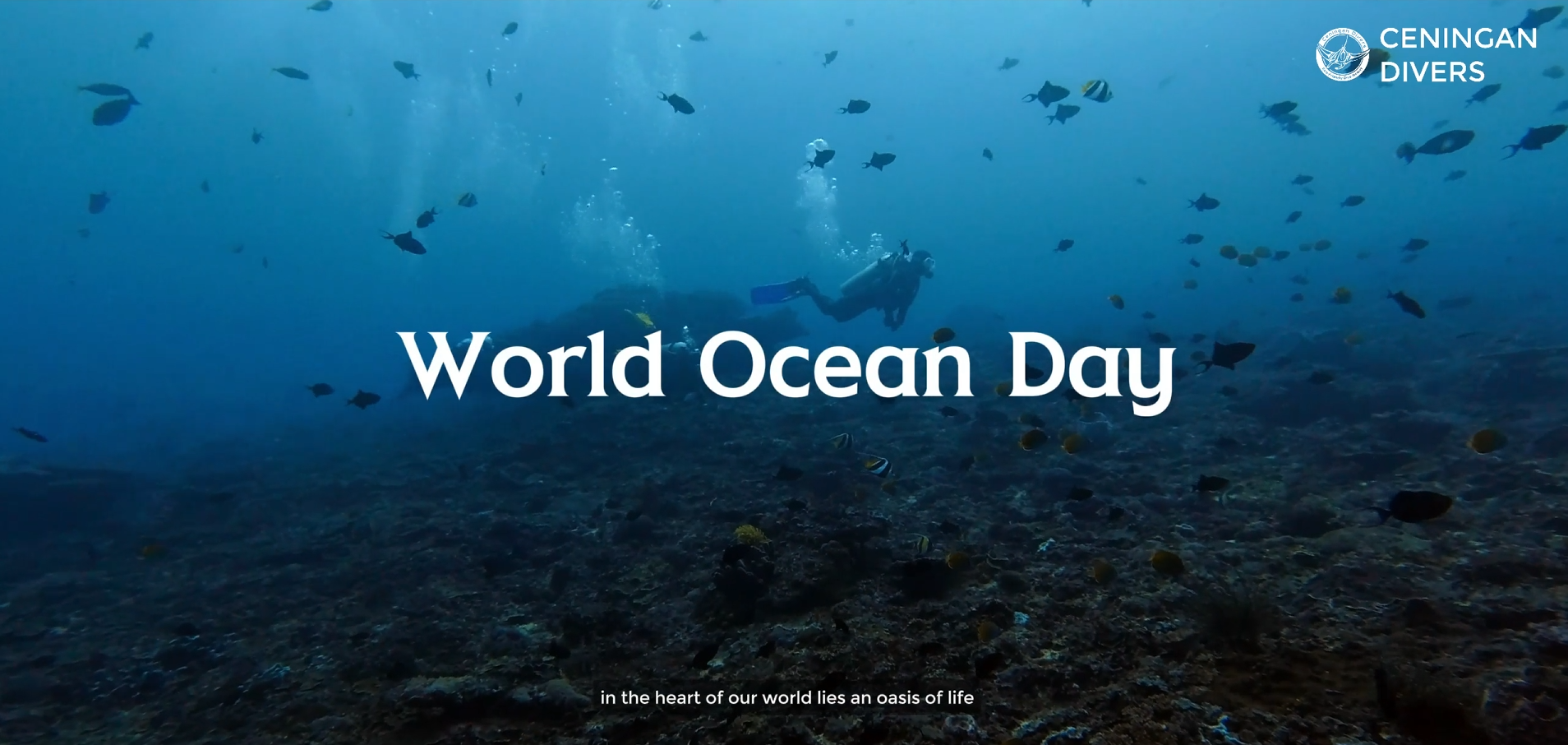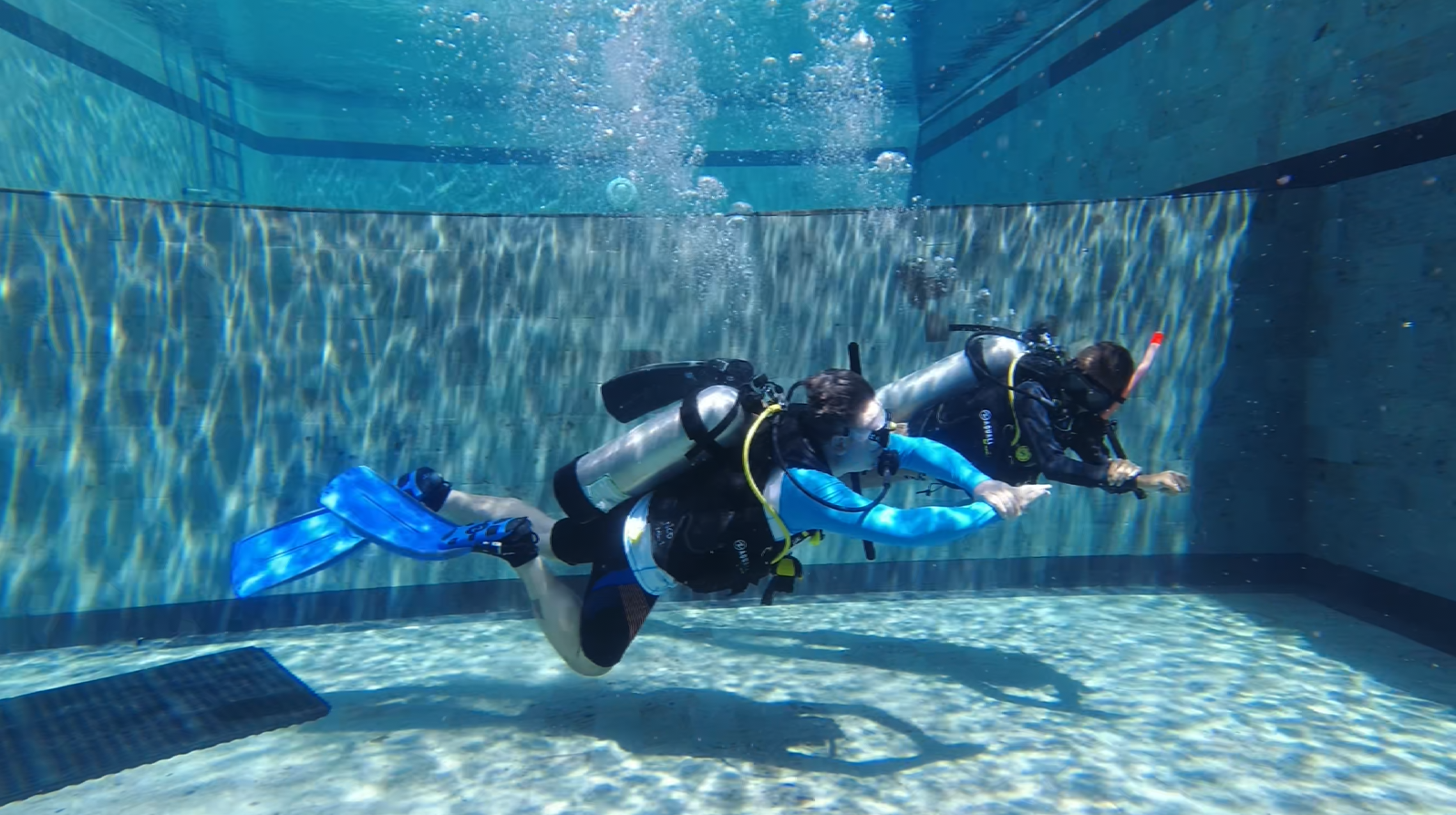L’une des principales raisons pour lesquelles les plongeurs affluent vers les îles Nusa est l’opportunité rare de nager aux côtés du Mola, également connu sous le nom de poisson-lune océanique (Ocean Sunfish). Bien qu’ils puissent être trouvés dans les océans du monde entier, il n’existe que quelques sites de plongée où ils apparaissent de manière prévisible chaque saison. Pour tous ceux qui souhaitent voir un Mola lors de leur visite aux îles Nusa, il est intéressant de mieux comprendre ces géants mystérieux.
Mola sous tous ses noms…
L’un des aspects les plus intrigants du Mola est la multitude de noms sous lesquels il est connu. Peu de gens réalisent qu’il existe en fait cinq espèces différentes de poissons-lune dans le monde, toutes appartenant à la famille des Molidae :
-
Mola mola – Poisson-lune océanique, l’espèce la plus courante et l’une des plus grandes. C’est la plus susceptible d’être observée autour de Nusa Penida.
2. Mola alexandrini – Poisson-lune bossu, similaire au poisson-lune océanique, mais avec de grandes bosses sur la tête et le menton. Le plus grand poisson-lune jamais enregistré appartenait à cette espèce. (Photo : Ola Norman)
3. Mola tecta – Poisson-lune trompeur, nommé ainsi car il n’a été découvert qu’en 2017 ! Pendant longtemps, il a été confondu avec Mola mola, avant d’être officiellement identifié comme une espèce distincte. (Photo : Alex Hearn)
4. Masturus lanceolatus – Poisson-lune à queue pointue, comme son nom l’indique, il possède une queue pointue ressemblant à une gigantesque têtard. (Photo : H. Sugiyama)
5. Ranzania laevis – Poisson-lune élancé, le plus petit (et sans doute le plus mignon). (Photo : Tobias Bernhard / Minden Pictures)
Le nom de genre « Mola » a été choisi intentionnellement, car Mola en latin signifie « meule » (une pierre circulaire utilisée pour broyer les grains et les graines). La comparaison avec la forme ronde du poisson-lune est donc évidente.
Meule, crédit : Roger Griffith
Les noms communs de ce poisson varient beaucoup et décrivent généralement son apparence ou son comportement :
✔ « Sunfish » (poisson-soleil), car il flotte à la surface de l’eau pour se réchauffer au soleil.
✔ En allemand, il est appelé « Schwimmender Kopf » (tête flottante).
✔ Dans de nombreuses autres langues, il est connu sous le nom de « poisson-lune », en raison de sa forme circulaire grise et de ses taches ressemblant à des cratères lunaires.
Le nom « Mola mola » est heureusement facile à retenir – il s’agit tout simplement de la répétition du genre et de l’espèce.
Mola se prélassant au soleil, crédit : Paul Nicklen Photography
Anomalies anatomiques
Le poisson-lune est le plus grand poisson osseux du monde. Il est important de noter que, bien qu’il existe des poissons plus grands, ceux-ci sont des poissons cartilagineux, qui possèdent un squelette composé de cartilage et non d’os (par exemple, les requins).
Le poisson-lune peut atteindre plus de 3 mètres de hauteur, du sommet de sa nageoire dorsale jusqu’à l’extrémité de sa nageoire anale. Il peut également peser plus de 1 000 kg, avec un record enregistré à 2 300 kg pour un poisson-lune bossu (Mola alexandrini).
Un élément notable de son anatomie est l’absence de nageoire caudale (ou nageoire de queue). À la place, celle-ci a été remplacée par un « clavus », une extension des nageoires dorsale et anale qui se rejoignent à l’arrière du poisson. Le clavus sert uniquement à diriger ce poisson en forme de disque géant, lui donnant l’apparence d’avoir un « postérieur ».
Un autre élément inhabituel est l’absence de vessie natatoire, un organe qui aide normalement les poissons à monter et descendre dans la colonne d’eau. À la place, le poisson-lune se déplace grâce à la propulsion de ses puissantes nageoires, et sa tissu corporel gélatineux lui permet de rester en flottabilité neutre.
Une créature sociale
Nettoyage des poissons-lunes, crédit : Jordi Chias Pujol
Étant donné que les poissons-lunes sont lents et passent beaucoup de temps en profondeur, ils comptent sur d’autres animaux pour les aider à se débarrasser de leurs parasites. Les poissons-lunes remontent à la surface et s’approchent des récifs pour être nettoyés par des oiseaux et d’autres poissons, tels que les poissons-cochers.
Lors de la saison sèche à Nusa Penida, il n’est pas rare de voir des bancs de poissons-cochers attendre au bord des récifs, jusqu’à ce qu’un poisson-lune apparaisse pour un nettoyage en profondeur. En captivité, les poissons-lunes secourus s’adaptent facilement et apprennent rapidement à être nourris à la main par le personnel des aquariums.
De minuscules larves aux géants des océans
Le cycle de vie du poisson-lune reste encore mystérieux. De nombreuses recherches sont en cours pour mieux comprendre comment ces poissons grandissent, et nous espérons que de nouvelles informations émergeront à l’avenir.
Les poissons-lunes pondent leurs œufs en pleine mer, et les larves qui en éclosent ne mesurent que quelques millimètres. Ces jeunes larves ne ressemblent pas du tout à leurs énormes parents ; elles ont en réalité l’apparence de minuscules poissons-globes ou poissons-hérissons, ce qui n’est pas surprenant puisqu’ils appartiennent au même ordre des Tetraodontiformes.
Bébé poisson-lune, crédit : Museum of Comparative Zoology, Université Harvard
Bien qu’ils commencent leur vie à une échelle minuscule, il ne faut pas longtemps à un poisson-lune pour atteindre des tailles gigantesques. Selon des études de croissance, un poisson-lune peut multiplier sa taille par 60 millions une fois adulte !
La durée de vie exacte d’un poisson-lune reste incertaine, mais en captivité, ils vivent en moyenne 10 ans. Dans la nature, on estime qu’ils peuvent atteindre jusqu’à 100 ans.
Un appétit insatiable
Pour atteindre ces tailles impressionnantes, les poissons-lunes doivent se nourrir… énormément. Bien qu’ils ne soient pas considérés comme des prédateurs très agiles, leur alimentation est principalement composée de méduses, mais aussi de petits invertébrés au corps mou tels que des siphonophores, calmars et crustacés.
Ils possèdent de grandes dents fusionnées, formant un bec puissant, ainsi qu’un jeu secondaire de mâchoires internes avec de multiples dents acérées leur permettant de déchiqueter leurs proies. Lorsqu’ils se nourrissent, les poissons-lunes aspirent et recrachent leur nourriture jusqu’à ce qu’elle soit réduite en morceaux plus faciles à ingérer.
On pense qu’ils peuvent tolérer la consommation de méduses grâce à une couche protectrice de mucus tapissant leur gorge.
Des proies faciles
Mola vs Lion de Mer, crédit : Ralph Pace
Avec une taille imposante et des mouvements lents, il n’est pas surprenant que les poissons-lunes soient la proie d’orques, de lions de mer et de requins. Les lions de mer sont même connus pour mâchouiller toutes leurs nageoires, laissant ces poissons sans défense mourir lentement et tragiquement.
Ils sont également considérés comme un mets délicat dans certains pays comme le Japon, la Corée du Sud et Taïwan. En Chine, il existe même un marché de produits médicinaux fabriqués à partir de poissons-lunes.
Cartographier les Mola
Bien que les poissons-lunes soient présents dans la plupart des océans du monde, ils passent la majorité de leur temps dans les eaux profondes et froides, où peu de plongeurs ont la chance de les observer.
Les deux meilleurs endroits au monde pour plonger avec les Mola sont Bali et les Galápagos. On pense que ces sites bénéficient d’un phénomène d’upwelling, où des eaux froides et riches en nutriments remontent à la surface. Cela attire les méduses, leur principale source de nourriture, et les poissons-lunes suivent donc ce mouvement.
Les sites de plongée autour de Nusa Lembongan, Nusa Ceningan et Nusa Penida sont d’excellents endroits pour observer les Mola, en particulier pendant la saison sèche, de la mi-juin à la mi-octobre. Durant cette période, les eaux plus froides incitent les Mola à remonter vers les stations de nettoyage pour se débarrasser de leurs parasites.
Bien qu’il soit impossible de garantir une rencontre avec un Mola, notre équipe connaît les meilleurs sites et les signes annonciateurs de leur présence. Juillet et août sont les mois les plus propices aux observations, bien que les poissons-lunes puissent être aperçus tout au long de la saison.
Il est important de noter que même s’ils remontent vers les eaux peu profondes, ils sont généralement trouvés entre 18 et 40 mètres de profondeur.
Plonger avec les Mola
Afin de minimiser notre impact sur le comportement naturel des Mola, des régulations strictes ont été mises en place pour tout plongeur rencontrant ces géants paisibles. Ces directives ont été développées par des experts en comportement des Mola, des chercheurs et des professionnels de la plongée, garantissant à la fois la sécurité des animaux et la préservation des stations de nettoyage pour les futures observations.
Code de conduite pour l’interaction avec les poissons-lunes
✅ Approchez toujours le Mola lentement et dans son champ de vision.
✅ Si le poisson est dans une station de nettoyage, attendez qu’il y reste au moins 1 minute avant d’approcher. Maintenez une distance d’au moins 3 mètres.
✅ Si le poisson nage librement, maintenez une distance de 10 mètres.
Ne touchez jamais et ne nourrissez jamais un poisson-lune. Il possède une couche de mucus protectrice qui le protège des parasites.
Ne nagez pas derrière le poisson-lune, cela pourrait l’effrayer.
Ne nagez pas sous le poisson-lune, car les bulles de plongée peuvent perturber le processus de nettoyage.
Ne bloquez jamais un poisson-lune lorsqu’il se déplace vers une station de nettoyage ou une issue de fuite.
N’utilisez pas de flash lors de la photographie, cela peut déranger et stresser l’animal.
Ne faites pas de bruits inutiles et évitez l’utilisation de véhicules à propulsion motorisée.
✅ Ne plongez qu’avec des centres qui respectent et appliquent ce Code de Conduite.
✅ Suivez toujours les instructions de votre guide de plongée.
Nous devons nous rappeler que voir un Mola lors d’une plongée est un privilège, et non un droit. Il fut un temps où trop d’interactions agressives et directes ont poussé les Mola à fuir nos sites de plongée.
En choisissant de plonger avec des centres respectant ces protocoles, nous pouvons garantir la présence continue de ces créatures fascinantes, afin que tout le monde puisse continuer à en profiter dans le futur.
Bibliographie
https://www.nationalgeographic.com/animals/fish/o/ocean-sunfish/
https://www.dive-the-world.com/creatures-sunfish.php
https://australianmuseum.net.au/learn/animals/fishes/southern-ocean-sunfish-mola-ramsayi/
https://www.aquarium.co.za/blog/entry/everything-you-need-to-know-about-ocean-sunfish
http://www.montereybayaquarium.org/animal-guide/fishes/ocean-sunfish


